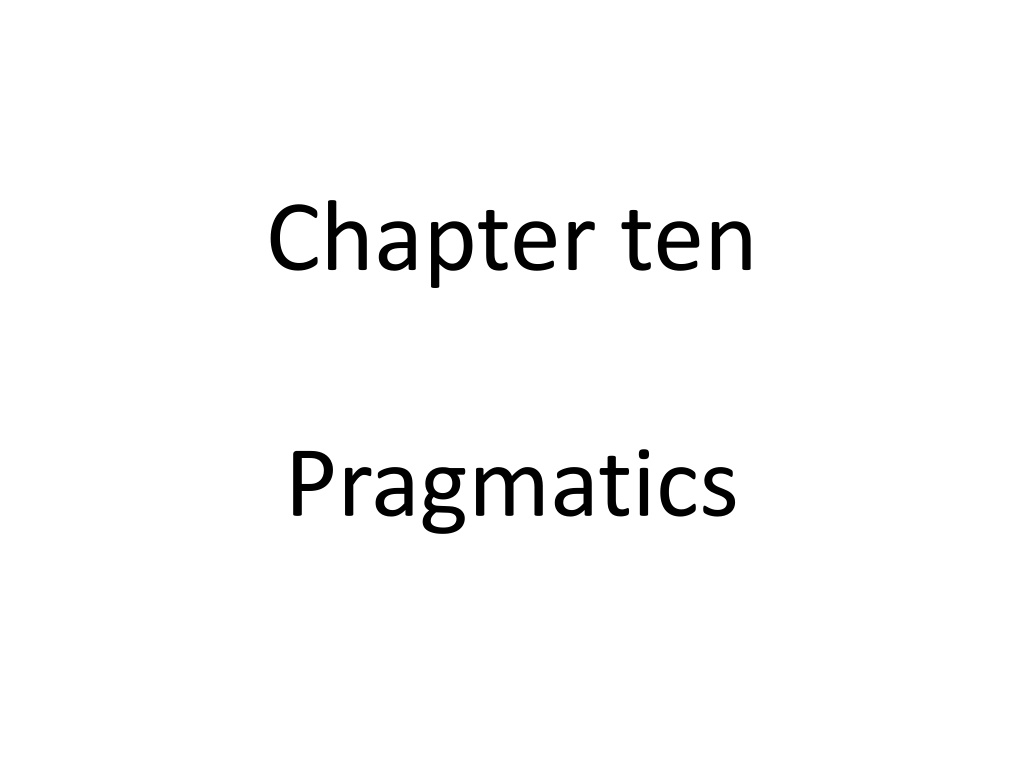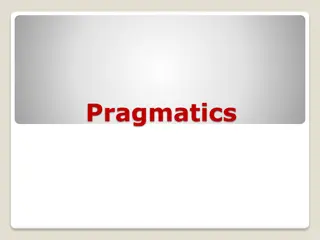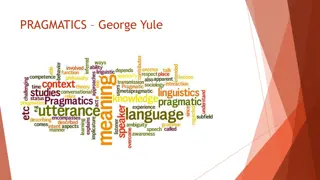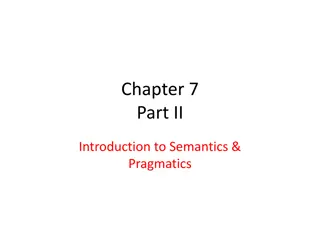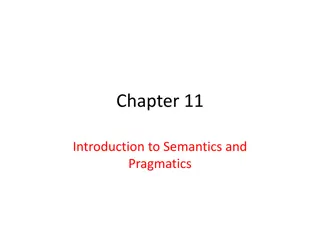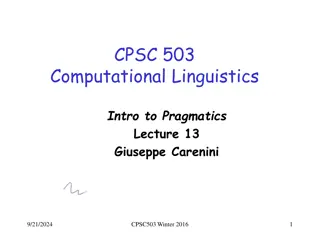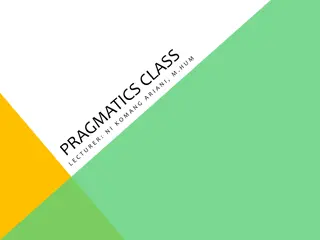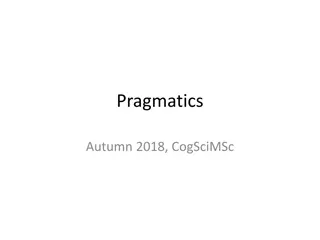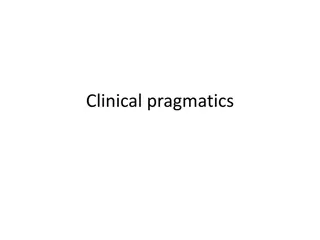Understanding Pragmatics in Communication
Pragmatics in communication involves recognizing not just the literal meaning of words, but also understanding the speaker's intentions and context. It delves into invisible meanings, shared assumptions, and expectations that shape communication. This includes linguistic and physical context, deixis with common English words, and reference to identify things. Dive into the study of pragmatics to unravel the nuances of effective communication.
Download Presentation

Please find below an Image/Link to download the presentation.
The content on the website is provided AS IS for your information and personal use only. It may not be sold, licensed, or shared on other websites without obtaining consent from the author. Download presentation by click this link. If you encounter any issues during the download, it is possible that the publisher has removed the file from their server.
E N D
Presentation Transcript
Chapter ten Pragmatics
Pragmatics Pragmatics: Communication depends not only on recognizing the meaning of words in an utterance but recognizing what the speakers mean by their utterance. i.e. there are aspects of meaning that depend more on context and the communicative intentions of the speaker. The study of speaker meaning (or intention) is called pragmatics.
Pragmatics is the study od invisible meaning/ i.e. how we recognize what is meant even when it is not actually said or written. Thus we have to depend on a lot of shared assumptions and expectations when we try to communicate. See heated attendant parking and baby examples in book In order to reach a correct understanding we have to use: 1/ the meaning of the words (lexical) 2/ the context in which they occur 3/ and some pre-existing knowledge of the world Thus, our interpretation of meaning is not based solely on words but on what we think the writer intended to communicate.
Context There are two types of context: 1/Linguistic Context also known as Co-text which describes the set of other words used in the same phrase or sentence. The surrounding co-text has a strong effect on the meaning of words. E.g., the homonym bank in She has to get to the bank to withdraw some cash. we know from the linguistic context which type of bank is intended 2/ Physical context: We can interpret the meaning of words on the basis of the physical context. E.g., if a building in the city has the word BANK written on it , the physical location will influence our interpretation. Our understanding of what we read and hear is tied to the time and place in which we encounter linguistic expressions.
Deixis Some common words in English that can t be interpreted at all if we don t know the immediate physical context of the speaker./ i.e. at the time of the utterance E.g., here, there, this, that, now, then, today, yesterday, tomorrow Pronouns, you, me, he, she, it, them You ll have to bring it back tomorrow because she isn t here today. Deictic expressions: bits of language that we can only understand in terms of the speaker s intended meaning. We use deixis to point to : Person deixis (things: it, this, these boxes) or people (him, them, those) Spatial deixis/ location (here, there, near) Temporal deixis/ time (now, then, last week) All these expressions have to be interpreted in terms of which person, place or time the speaker has in mind. E.g., Here she comes There she goes
Reference Reference: an act by which a speaker (or writer) uses language to enable a listener (or reader) to identify something. We can use either: Proper nouns (Chomsky, Jennifer) Other nouns in phrases (a writer, my friend, the cat) Or pronouns (he, she, it) The reference depends on who is using it because for every word or phrase there is a range of reference. E.g. the war example in the beginning of the chapter We can also refer to things when we are not sure what to call them. The blue thing The icky stuff
Inference Inference: is additional information used by the listener to create a connection between what is said and what must be meant./ i.e. they are mental calculations we have to do to reach an understanding, e.g., Can I look at your Chomsky? Sure, it s on the shelf over there. In order to understand the utterance we have to make the inference: if X is the name of the writer of the book, then X can be used to refer to a copy of a book by the writer. Remember that it is performed by the listener (or reader). See examples: Picasso is in the museum. We saw Shakespeare in London. Jennifer is wearing Calvin Klein.
Anaphora Anaphora: a subsequent reference to an already introduced entity./ mostly we use anaphora in a text to maintain reference. The first mention is called an antecedent. We saw a puppy in a home video. (antecedent) The puppy was struggling and shaking. (anaphoric expression) It jumped out of the bath and ran away. (anaphoric expression) The connection between an antecedent and an anaphoric expression is created by using: Pronouns (it) Or a phrase with the plus a noun (the puppy) Or another noun related to the antecedent (the little dog) Such connections are made by using inference We found a house to rent but the kitchen was very small. if X is a house then X has a kitchen
Presupposition Presupposition: what a speaker (or writer) assumes is true or known by a listener (or reader) We design our linguistic messages based on assumptions about what our listeners already know Remember that it is performed by the speaker (or writer) Your brother is waiting outside. (there is an obvious presupposition that you have a brother) When did you stop smoking? Why did you run the red light?
Speech acts Speech acts: the action performed by a speaker with an utterance. to describe actions such as requesting , commanding , questioning or informing E.g., I ll be there at six. (you are not just speaking, you are promising )
Direct and Indirect speech acts Structure Function Did you eat the pizza? ? ? Eat the pizza! ? ? You ate the pizza. ? ? Direct speech acts: for example, when we use an interrogative structure (e.g., Did you..?) with the function of a question/ i.e., we don t know something and we are asking someone to provide information. Indirect speech acts: for example, when we use the interrogative structure but we are not really asking for information/ we use it to make a request. Can you pass the salt? You left the door open. Thus, whenever one of the three syntactic structures is used to perform a function other than its normal function the result is an indirect speech act. Miscommunication could happen if one person fails to recognize another person s indirect speech act. Do you know where the Ambassador hotel is? Yes I do. (and walks away) (its an indirect speech act used as a request not as a question)
Politeness Face: your face in pragmatics is your public self-image./ the emotional and social sense of self that everyone has and expects everyone else to recognize. Politeness: showing awareness and consideration of another person s face. Face-threatening act: behaving as if you have more social power than the other person Give me that paper! Face-saving act: when you say something that lessens the possible threat to another s face. Could you pass me that paper? (the indirect speech act in the form of a question removes the social power/ the request is less threatening)
Negative and positive face Negative: the need to be independent and free from imposition./ shows concern about imposition I m sorry to bother you, but . Positive face: the need to be connected, to belong, to be a member of a group./ shows solidarity Let s do this together . The appropriate use of language for politness differs from culture to culture.
